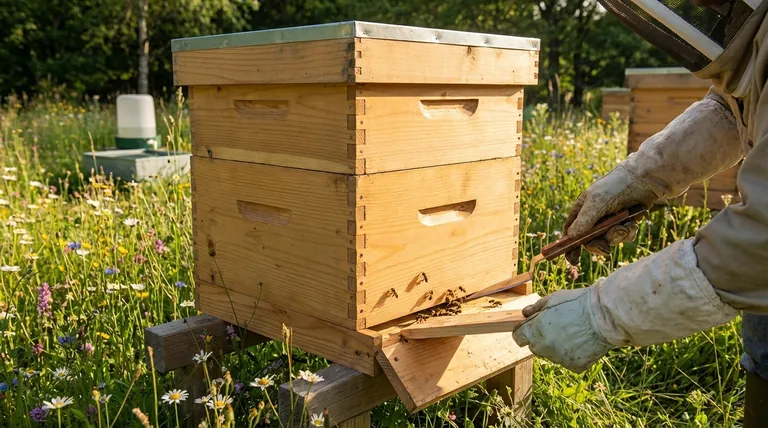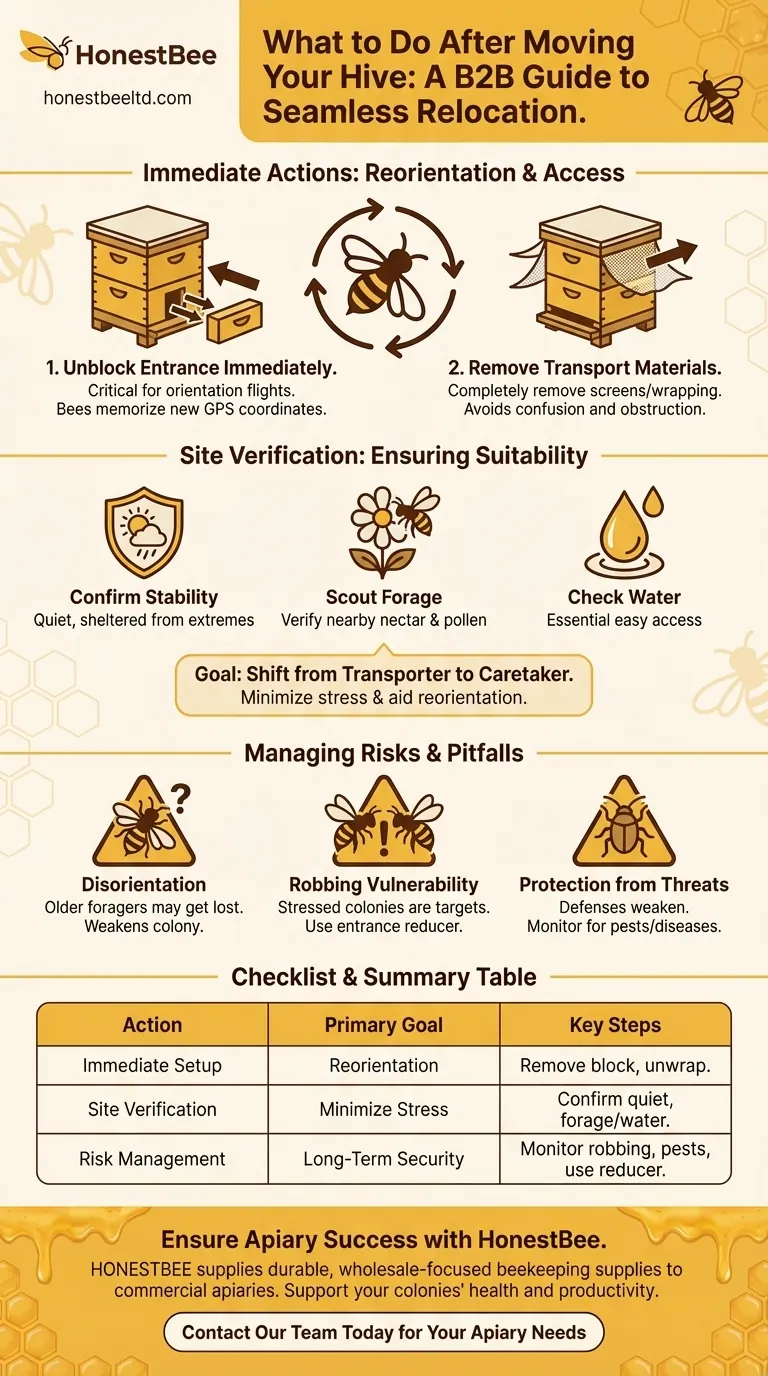Once your hive is in its new location, your first actions are critical for the colony's reorientation. The immediate, essential steps are to remove the entrance block and completely unwrap any transport materials, such as tulle or screens. This allows the bees to emerge and begin the crucial process of mapping their new GPS coordinates.
Moving a hive is a significant disruption for a colony. Your post-move goal is to shift from transporter to caretaker, focusing on minimizing stress and helping the bees accept their new environment as a safe and resource-rich home.

The Critical First Steps: Reorientation and Access
Your immediate actions signal to the colony that the journey is over and it's time to learn their new surroundings.
Immediately Unblock the Entrance
This is the single most important first step. The moment you unblock the entrance, forager bees will begin to perform orientation flights.
These are short, circular flights in front of the hive where they meticulously memorize the visual landmarks of their new home. Delaying this prevents them from re-establishing their internal map.
Remove All Transport Materials
Any screens, netting, or wrapping used to contain the bees during transport must be removed completely.
Leaving materials in place can obstruct the entrance, confuse the bees, and prevent them from fully settling in. Ensure the hive entrance looks exactly as it should for normal operation.
Verifying the Suitability of the New Site
Now that the bees can exit, your focus shifts to confirming the environment supports their successful transition.
Confirm Environmental Stability
Your pre-move planning was vital, but now is the time to do a final check. The location should be quiet, clean, and sheltered from extreme conditions like direct, all-day sun or areas prone to flooding.
A stable environment reduces the colony's stress, allowing them to focus on reorienting rather than fighting the elements.
Scout for Nearby Forage and Water
The colony's foragers will soon be searching for resources. Confirm that there are nearby food sources like flowering plants, meadows, or gardens.
Easy access to nectar, pollen, and water is crucial for a colony that has just undergone the stress of a move.
Understanding the Risks and Common Pitfalls
A relocated hive is temporarily vulnerable. Understanding the risks allows you to mitigate them effectively.
The Risk of Disorientation
Even with a perfect move, some older forager bees may become disoriented. Their strong memory may cause them to return to the hive's original location, especially if the move was short.
This is a natural part of the process, but a significant loss of foragers can weaken the colony.
Increased Vulnerability to Robbing
A stressed and disorganized colony emits signals that other honeybees and wasps can detect. This makes them a prime target for robbing, where stronger colonies invade to steal their honey.
Using an entrance reducer can help a smaller or disoriented colony defend itself more effectively.
Protection from Threats
The stress of the move can temporarily weaken a colony's defenses against pests, predators, and diseases.
Be extra vigilant in the days following the move. Monitor for signs of pests like hive beetles, watch for predators, and avoid introducing any potential contaminants to the new site.
A Checklist for a Successful Relocation
Your post-move actions should align with the primary goal of helping the colony adapt quickly and safely.
- If your primary focus is immediate reorientation: Remove the entrance block and all wrappings without delay to allow orientation flights to begin.
- If your primary focus is minimizing colony stress: Confirm the new location is calm, sheltered, and has easily accessible food and water to ease the transition.
- If your primary focus is long-term security: Use an entrance reducer if needed and actively monitor for robbing, pests, and predators while the hive is vulnerable.
Thoughtful post-move care transforms a stressful relocation into a seamless transition for your bees.
Summary Table:
| Action | Primary Goal | Key Steps |
|---|---|---|
| Immediate Setup | Reorientation | Remove entrance block, unwrap transport materials. |
| Site Verification | Minimize Stress | Confirm location is quiet, sheltered, with nearby forage/water. |
| Risk Management | Long-term Security | Monitor for robbing, pests, and predators; use entrance reducer if needed. |
Ensure your apiary's success with the right equipment. A smooth hive relocation is just the beginning. HONESTBEE supplies durable, wholesale-focused beekeeping supplies and equipment to commercial apiaries and distributors. From hive tools to protective gear, our products are designed to support the health and productivity of your colonies. Let's discuss your apiary's needs — contact our team today to get started.
Visual Guide

Related Products
- HONESTBEE Premium Italian Style Hive Tool with Hardwood Handle
- Versatile Ratchet Hive Strap with S-Hooks for Secure Fastening
- Wholesales Dadant Size Wooden Bee Hives for Beekeeping
- Professional Galvanized Hive Strap with Secure Locking Buckle for Beekeeping
- Heavy Duty Ratchet Hive Strap
People Also Ask
- What is required for regular inspections in both Flow Hives and Langstroth hives? Essential Beekeeping Tasks Explained
- What are some common uses of a hive tool? Essential Multi-Purpose Tool for Every Beekeeper
- What is the hive tool used for? The Essential Multi-Tool for Every Beekeeper
- How should beekeepers handle bees when using a hive tool? Master Calm, Deliberate Techniques
- Is it advisable to manage a large number of hives alone? The Risks of Solo Beekeeping at Scale



















